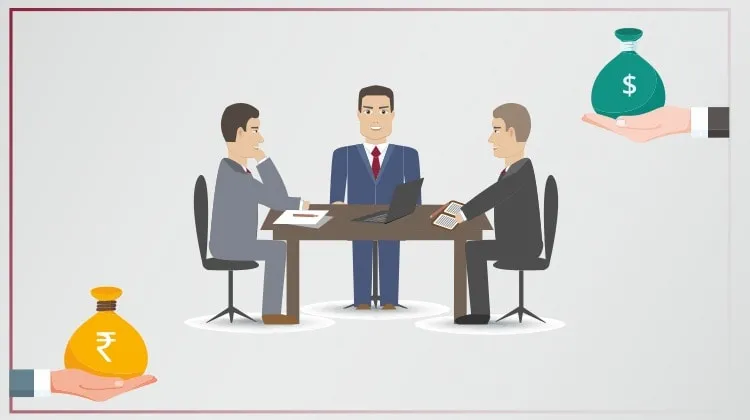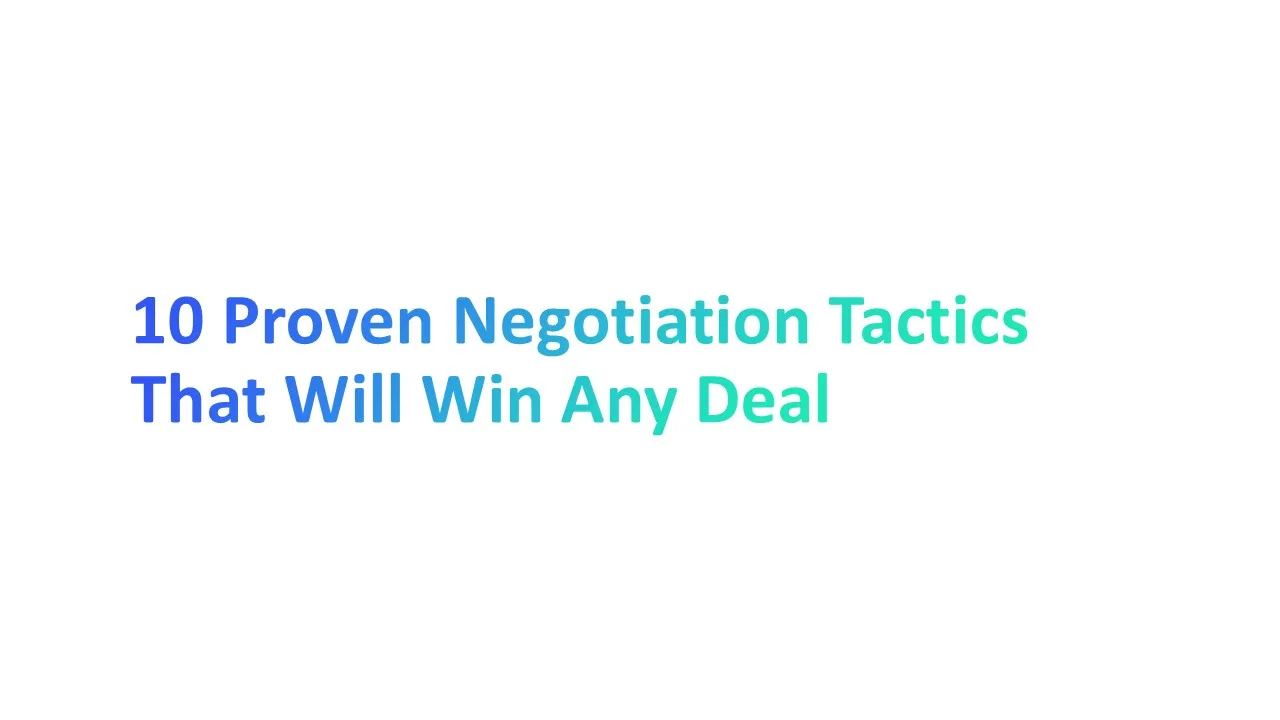Did you know that over 80% of successful business deals are made through effective negotiation tactics (Forbes)?
Whether you're closing a sale or reaching a crucial agreement, understanding and using the right tactics can make all the difference. Get ready to master these techniques and win every negotiation that comes your way!
What are Negotiation Tactics?

Negotiation tactics are smart techniques used to get what you want in a deal. The goal is to find a way to win, but also make sure the other party feels satisfied too.
You use different negotiation strategies, depending on who you're talking to and what the situation is. These tactics can help you reach an agreement, whether you're negotiating a price, creating a win-win outcome, or simply responding effectively to the demands of the other party.
Types of Negotiation Strategy

1. Distributive Negotiation ("Win-Lose")
Distributive negotiation is like dividing a pie. One party gets more, and the other gets less. It’s often called a "win-lose" strategy because both sides are trying to get the best deal for themselves.
For example, imagine you're buying a used bike. If you want to lower the price, you’re aiming to "win." If the seller doesn't lower the price, they “win.”
How to use it:
You should use distributive negotiation when you don’t need to build a long-term relationship with the other party.
Here, the goal is to get the best price or terms for yourself. A common negotiation tactic is to start with a high demand or low offer and move toward the middle.
For example, if you’re buying a car, you might offer a very low price and gradually increase it, aiming to meet somewhere in between.
Best practices:
- Know your BATNA (Best Alternative to a Negotiated Agreement): Before entering a distributive negotiation, know what your best backup plan is if the negotiation fails.
- Stay firm but fair: Stand your ground on important points but be willing to compromise on smaller issues.
Distributive negotiations work best when you have a clear goal and aren’t worried about the other party’s long-term relationship.
2. Integrative Negotiation ("Win-Win")
Integrative negotiation is all about finding a win-win outcome. It's like baking a bigger pie so both parties can have a bigger slice.
You look for ways to create value, making sure both sides leave the bargaining table feeling satisfied. Let’s say you and a friend are deciding how to spend the weekend.
If you both love hiking and movies, you can plan a day that includes both, so both of you win.
How to use it:
Integrative negotiation is best when both parties are looking for a long-term relationship or a fair agreement.
A great negotiation tactic here is active listening. Try to understand the needs and interests of the other side.
For instance, if you’re working with a potential buyer, ask what features or benefits matter most to them. Once you understand their interests, you can offer solutions that work for both you and them.
Best practices:
- Build trust: The more the parties involved trust each other, the easier it is to find a win-win solution.
- Be creative: Look for opportunities where both sides can benefit. Think outside the box to create value.
An integrative negotiation style focuses on collaboration, making sure that both parties are happy with the final outcome.
3. Principled Negotiation (Interest-Based Approach)
Principled negotiation is about focusing on interests, not positions. It’s a strategy where you look beyond what people say they want and try to understand why they want it.
This method was made popular by the book "Getting to Yes" by Roger Fisher and William Ury.
For example, if you're arguing over where to go for dinner, the position might be “I want pizza,” but the best interest here could be “I want something quick and affordable.”
How to use it:
This negotiation style works well when you want to build strong, fair agreements based on shared interests.
The main tactic is to ask "why?" to uncover the real needs behind each party’s position. By focusing on interests, you can come up with solutions that address the needs of both sides.
Best practices:
- Separate people from the problem: Treat the negotiation as a joint effort to solve a problem, not a battle between you and the other party.
- Use objective criteria: When possible, rely on facts, market value, or standards to support your argument, rather than just personal opinions.
Principled negotiation is helpful in situations where you want to create a fair, lasting agreement and maintain a positive relationship.
4. BATNA-Oriented Negotiation
BATNA stands for "Best Alternative to a Negotiated Agreement." It’s a fancy way of saying "your backup plan."
Before entering any negotiation, it's important to know your BATNA – what you’ll do if you can’t reach an agreement with the other party.
Think of it like this: If you’re trying to buy a game console but can’t get the price you want, your BATNA might be to buy a similar console from another store.
How to use it:
To use BATNA effectively, figure out what your best option is if the current deal doesn’t work out. This helps you know when to walk away.
For example, if you're negotiating the price of a car and it’s too high, knowing your BATNA (perhaps buying a different car) can help you negotiate from a stronger position. The better your BATNA, the more power you have in the negotiation.
Best Practices:
- Always have a backup: Knowing your BATNA gives you confidence during the negotiation process.
- Know the other side's BATNA: If you understand the other party’s best alternative, you can use that information to your advantage.
5. ZOPA-Focused Negotiation (Zone of Possible Agreement)
ZOPA stands for "Zone of Possible Agreement." This zone is the range where both parties can agree.
For example, if you want to sell your bike for $100 and the buyer is willing to pay between $80 and $120, the ZOPA is between $80 and $120. It’s the sweet spot where both sides can be happy.
How to use it:
To use ZOPA effectively, both you and the other party should know your minimum and maximum limits. Find out where those limits overlap.
That overlap is your ZOPA. If both sides are clear about this range, it becomes easier to create a win-win outcome.
Best Practices:
- Determine your limits: Know the least and the most you're willing to accept before the negotiation starts.
- Find common ground: Work with the other party to identify the ZOPA and stay within it during the negotiation.
6. Competitive vs. Collaborative Strategies (Situational Flexibility)
In any negotiation, you may need to choose between being competitive or collaborative.
A competitive strategy means you're focused on winning – getting the best deal for yourself. This is often seen in situations like auctions, where everyone wants to pay the lowest price.
On the other hand, a collaborative strategy aims for a solution that benefits both you and the other party. It's about working together for a win-win situation, like when you're trying to solve a business problem with a partner.
How to use it:
- Use a competitive approach when: You need the best deal for yourself, and there’s no need for a long-term relationship with the other party. For instance, when buying a used phone, you might focus solely on lowering the price.
- Use a collaborative approach when: Both parties can benefit from working together, and building a good relationship is important. For example, when you and your business partner are deciding how to split profits, you might look for a fair balance that benefits you both.
Best Practices:
- Be flexible: Situational flexibility is key. Decide which strategy works best depending on the negotiation.
- Build relationships when possible: If you’re looking to create a lasting partnership, a collaborative strategy will help both sides reach a better deal and build trust.
Proven Negotiation Tactic to Use

1. Analyze the Negotiation Process: Set the Stage for Success
Before you jump into a negotiation, it’s crucial to analyze the negotiation process. Think about how the discussion might flow, what the other party wants, and how you can guide the conversation to reach an agreement. The goal here is to prepare yourself mentally and practically for what's coming.
Why is it important:
Planning helps you feel confident and stay focused on the desired outcome. When you know what you want, and you understand the other party's perspective, it's easier to navigate the negotiation process.
For example, if you're negotiating a job offer, knowing what the company values and what they're likely to agree to will help you secure the best deal.
How to implement it:
- Research the other party: Learn about their needs, values, and priorities. The more you know, the better you can prepare.
- List your goals and limits: What is your ideal outcome? What’s the lowest offer you're willing to accept? Write these down so you’re ready to stay firm on what matters most to you.
- Visualize the negotiation: Imagine how the conversation might go. Think of potential objections and how you would respond effectively to them. For example, if you think the other party might demand a lower price, prepare reasons why your price is fair.
2. Understand the Other Party
Negotiation is like a dance. You and the other party need to move together to reach a successful outcome. Understanding what the other side wants is essential for finding common ground.
When you know their needs, fears, and motivations, it becomes easier to guide the negotiation in a direction that benefits both you and them.
Why is it important:
Knowing the other side’s perspective helps you create win-win outcomes. One of the best negotiation tips is to stay calm and listen actively to the other party.
For instance, if you're selling a product to a potential buyer, understanding their pain points or what benefits they’re looking for can help you frame your offer more effectively.
It shows that you care about their needs, which makes them more likely to agree.
How to implement it:
- Ask questions and listen: Ask the other party about their needs and what they're looking for in the deal. Actively listen to their answers. You can uncover valuable insights about their priorities.
- Empathize: Put yourself in their shoes. How would you feel if you were them? What would you want? Understanding their point of view builds trust.
- Adjust your strategy: Use what you learn to tweak your approach. For example, if you find out that the other party values quick delivery, emphasize how your service can meet that need.
3. Common Negotiation Tactics for Different Situations
There isn’t one "right" way to negotiate; it depends on the situation. There are common negotiation tactics you can use based on the situation and the type of deal you're working on.
Some tactics work best in tough situations, while others are better when trying to maintain a long-term relationship.
Why are they important:
Using the right tactic at the right time can help you reach a negotiated agreement faster and more effectively.
For example, if you're at a bargaining table and trying to close a deal quickly, a "take-it-or-leave-it" tactic might be powerful. But in other cases, the negotiation examples, you might want to build rapport and slowly find a middle ground.
How to implement it:
- Choose the right style: Decide between competitive and collaborative negotiation styles. If it's a one-time deal, you might be more competitive. If it's a long-term partnership, focus on collaboration.
- Be flexible: Adapt your tactics as the negotiation progresses. If the other side is firm, you might need to match their firmness. If they are open to ideas, you can brainstorm together for a win-win situation.
- Be ready to compromise: Not every deal will be perfect, and sometimes both parties need to give a little. Know which parts of the deal are most important to you, and be willing to let go of the less crucial parts.
4. Hard Bargaining Tactic
A hard bargaining tactic is when you stay firm and strong in your position during negotiations. You stick to what you want and push to achieve the best deal for yourself.
Imagine you are at a yard sale, and you find a bike you really want. The seller wants $100, but you only have $60. A hard bargaining tactic would be to stick to your $60 offer and not budge easily.
Why is it important:
This tactic is useful when you want to maximize your benefits and don’t need a long-term relationship with the other party.
It works best when the goal is to get the best deal at that moment, like a one-time business deal making, or buying an item where you want to lower the price as much as possible.
How to implement it:
- Set your limits: Decide what is the highest or lowest you are willing to go in a negotiation.
- Stay firm but polite: Be confident in what you want, but keep the conversation friendly. For example, “I understand your price, but $60 is my final offer.”
- Know when to walk away: If you can’t reach a negotiated agreement that meets your needs, be ready to walk away. Walking away can sometimes make the other side give you a better deal.
5. Body Language and Human Nature in Negotiation
Body language is how your body “talks” when you’re negotiating. It includes your eye contact, posture, and even your facial expressions.
Understanding human nature means knowing how people might react in different situations.
For example, crossing your arms can show that you’re feeling defensive, while smiling and nodding can make the other party feel comfortable.
Why is it important:
Using body language well helps build trust and makes the other side feel understood. By knowing how human nature works, you can respond effectively to the other party's feelings.
For instance, if someone looks unsure, you can ask questions to make them feel more confident in the deal.
How to implement it:
- Keep open body language: Face the other party, make eye contact, and avoid crossing your arms. This shows that you’re open to talking.
- Watch for clues: Look for signs from the other side. Are they fidgeting? Are they looking away? These may be signs they’re uncomfortable or unsure.
- Mirror their actions: If the other party is relaxed, try to be relaxed too. This can help them trust you and create a more friendly negotiation atmosphere.
6. Create Win-Win Outcomes: Turn Conflict into Mutual Success
Creating win-win outcomes means making sure both you and the other party leave the negotiation happy. It’s about finding an agreement that benefits everyone involved, not just one side.
Imagine you and your friend are sharing a pizza. A win-win situation would be finding toppings you both enjoy, so everyone gets what they like.
Why is it important:
This approach builds strong relationships and trust. When both sides feel like they have won, they are more likely to work together in the future.
For example, in business, if both companies benefit from a deal, they will want to continue working together for future success.
How to implement it:
- Listen to the other party's needs: Ask questions to understand what the other side wants from the negotiation. If they value quick delivery, try to find a way to meet that need.
- Brainstorm solutions together: Think of ideas that benefit both you and them. Say something like, “How can we make this work for both of us?”
- Stay flexible: Be willing to adjust your offer if it means both sides can benefit. A good win-win outcome means compromise, so be open to give-and-take.
7. Respond Effectively: Deal with High Demands and Difficult Negotiators
Sometimes, you may negotiate with someone who has very high demands. They might want more than what seems fair, or they may be a difficult negotiator who won’t back down.
Responding effectively means knowing how to handle these situations without losing sight of your goals.
Why is it important:
Being able to respond effectively can help you stay calm, control the negotiation process, and avoid giving in to demands that don’t benefit you.
It’s like playing a game where the other party tries to make the rules — but you know how to play it better.
How to implement it:
- Stay calm and listen carefully: If the other side is making high demands, don’t panic. Listen to what they want and try to understand their reasoning.
- Ask questions and dig deeper: Ask why they want what they are asking for. This can help you understand their needs and find common ground. For example, “Can you tell me why this term is so important to you?”
- Propose alternatives: If you can’t agree with their demands, offer different solutions that work for both parties involved. This shows that you are flexible and willing to find a middle ground, but you’re also standing firm on your value.
8. Leverage Your Negotiation Skills to Lock in the Best Deal
Leveraging your negotiation skills means using all the tactics, and strategies you know to get the best deal. It’s about being prepared, knowing your goals, and understanding the other party’s needs to create a win-win situation.
Why is it important:
Good negotiation skills help you get what you want while making the other party feel happy too. Whether you’re negotiating a business agreement, a purchase, or even a simple favor, using your negotiating skills smartly can help both sides reach a fair and successful outcome.
How to implement it:
- Prepare well: Know what you want and what your bottom line is. Research the other party’s needs and goals before the negotiation begins.
- Use clear communication: Clearly state what you want and why it benefits both you and the other side. For example, if you're negotiating a contract, highlight the benefits they will receive from the agreement.
- Build rapport and trust: People are more likely to agree to a deal if they trust you. Be friendly, honest, and respectful. It makes the negotiation process smoother and increases the chances of getting a good outcome.
9. Overcome Challenges in Negotiation Styles and Strategies
Negotiation styles can differ greatly. Some people may be cooperative, looking for a win-win outcome, while others may be more competitive and focus on getting the best deal for themselves. The key is to recognize the different negotiation styles and adapt your strategy to match the situation.
Why is it important:
Overcoming these challenges helps you be successful no matter who you’re negotiating with. By understanding the negotiation style of the other party, you can adjust your tactics to either be more collaborative or firm, depending on the situation.
How to implement it:
- Identify the style of the other party: Are they looking for a fair agreement, or are they pushing for the best deal for themselves? If they are cooperative, you can focus on creating value for both sides. If they are competitive, you may need to stand your ground and be firm.
- Use different strategies based on the style: If the other side is more cooperative, work together to find a solution. If they are more competitive, be prepared to use a hard bargaining tactic and know when to walk away.
- Stay flexible and adapt: If the negotiation isn’t going as planned, be ready to change your approach. Remember, the goal is to reach a beneficial agreement for both parties, so don’t be afraid to switch tactics if needed.
10. How to Walk Away: When to Know a Deal Isn’t Right
Walking away means deciding to stop the negotiation when the deal doesn’t meet your needs. It’s knowing that sometimes, no deal is better than a bad deal. Think of it like shopping: if the price is too high or the product isn't right, you don’t buy it.
Why is it important:
Walking away protects you from a bad agreement that could hurt you in the long run. It shows confidence and helps you find better opportunities later.
Remember, the other party might even come back with a better deal once they see you’re willing to walk away.
How to implement it:
- Set clear limits: Before negotiating, decide your bottom line. Know what you need from the agreement.
- Trust your gut: If the other party’s demands are too high or the deal feels unfair, be prepared to say, “No, thank you.”
- Stay polite and firm: Say something like, “This deal doesn’t work for me, but thank you for your time.” Then, confidently walk away, knowing you made the right choice.
Conclusion
Negotiation tactics is key to reaching great deals and positive outcomes. Remember that negotiation training is to understand the other party, respond effectively, and aim for a win-win situation. Use these skills wisely, and you'll be ready to walk away with confidence or make the best agreement possible.





.jpg)

.jpg)
